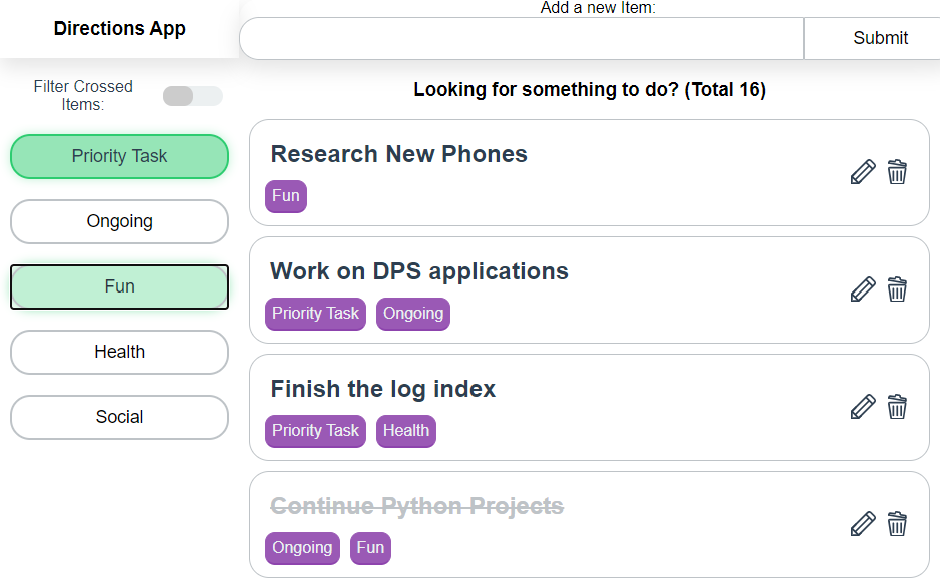The Directions App was an attempt to reconcile challenges around balancing complex responsibilities and needs in day-to-day life, inspired by a personal need.
A new take on the classic “work life balance” dichotomy, the Directions App presented all actions and responsibility as equal, and aimed to offer ‘mindless’ task direction without simply creating to-do lists.
This was a significant project to me, it was my first proper Redux application and allowed me to hone in React knowledge that I had previously only uses in fits and spurts.
Much later on, the notion of non-coercive task organisation and my findings from this project influenced the “traffic light system”, a component of my project Boots & the Future of Wellness.
View the live demo and repository with the links or read on to learn the backstory.
Backstory
Ok so we’ve all built To-Do lists, you learn the basics of a new MVC framework and can easily test your work. Then maybe, while continuing your learning, you make a version with data-persistence, probably with localstore or maybe something like Redis. Then if you really want to, you can set up a database and save the data permanently which is a great way to practice React-Express integration.
If you desire more in-depth productivity and planning tools there is no end or free software available to help you ‘do more, faster and smarter’ or ‘take control of your work’ or ‘plan every last detail’.
I found myself in a personal quandary. I, as ever, had a lot going on in my life. I was slowly coming to the realisation that just powering through; working endlessly, pushing myself beyond limits, just wasn’t working. Day’s blurred into one endless stream of “stuff”, with five things demanding my attention at once, an endless wish-list of things I’d like my life to have (or not have) “once this is all over”.
I would burn out, I was kept physically fit by running about all day but my health took a beating with regard to diet, sleep, and of course, mental state.
You are a machine
Everyone has at least some experience of living like this and maybe gave or received advice that sounds something like “You’re not a machine, you’re a person, you need time to breath and do other things”. I agree with this sentiment broadly but I think it misses something: a ‘machine’ of most types does not run endlessly, without “rest”, or without “breathing”.
The definition of machine is broad but lets generalise of a second, imagine an abstract “Machine”. A machine can run for a duration of time then needs repair. A machine can run at sustainable levels for long periods. A machine can be pushed beyond it’s quoted physical limits but with the cost of quicker time-to-fail or malfunction.
I don’t know about you but that sounds like a pretty good description of a person to me.
A person is a biological system that has needs and conditions with affect their behaviour and abilities in their ‘functioning’, living day to day life. To take some easy exemplars, if you don’t sleep enough, you can put in all the extra hours that you like but won’t necessary be as productive. If you write something while caffeinated it may have a different read to something written in a more subdued state. If you do work while a little tipsy you may find you peak in creativity and inspiration but make sloppy mistakes and quickly drop bellow productive levels.
Here’s one I still struggle with, if you are stuck on a problem, taking time away, rather than trying to power through, can let your subconscious process it in ways you are unable to, leading to faster solutions. As intuitive as it may be to step away while the clock is ticking.
“This is not a task-list”
So how exactly do you balance things when you have five ticking clocks and now, the pressure to do this “self care” thing you just learned about?
You could try a simple planner and a to-do list but these both have the issue of making everything a “task” to finish. Is walking in a park a task? Reading a few pages before bed? What about things that repeat, like if you are job searching and need to do a little every day? Do you continue on weekends? How much do you do a day? How do you measure it?
The Directions App was an attempt at doing just this, it ordered all items with equal weight, utilising a tag system to differentiate them.

- Priority: this denotes actual task items, things which need to be completed
- Ongoing: this is used for tasks which repeat for a duration of time
- Fun: used for recreational activities
- Health: used for activities which benefit health and well being
- Social: used to section social activities
In this way you could combine which would show items denoted by which filters were active. Looking to do something recreational but also healthy? Turn on ‘Fun’ and ‘Health’. Set some time aside for task work? Use ‘Priority’, and so on.
Looking back
I still have a fondness for this app even if I didn’t actually end up using it all that much after a while. It was a useful way to explore things which exist between boundaries such as something which is fun and enjoyable to do but is still ‘work’. I realised that by assigning everything a tag and grouping them together, I could see the interlink between various tasks but it didn’t work so well to actually designate time, to come up with that magic formula where everything is balanced and just falls into place.

On a stylistic note, it was useful for me to develop emerging styles and layout patterns which would be refined further later on, even if it looks somewhat garish now.

